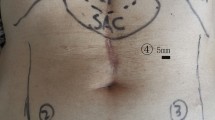Abstract
Background
Laparoscopic intraperitoneal mesh repair has become one of the most commonly performed minimally invasive procedures. Nevertheless, despite improved overall outcome, postoperative seroma formation remains the most frequent complication. Our objective was to investigate the effectiveness of cauterization of the hernia sac in terms of reducing the incidence of postoperative seroma formation.
Methods
A retrospective analysis of 94 patients who underwent standard laparoscopic intraperitoneal mesh repair without closure of the central defect (sIPOM) between June 2011 and December 2014 was conducted. In 20 of those cases, electric cauterization of the hernia sac was additionally performed (csIPOM). One-to-one propensity score analysis was conducted to overcome patient selection bias between the two surgical techniques. The case–control group was matched by gender, body mass index (BMI), patient comorbidities, and surface of the hernia defect. Patient demographics, pre- and postoperative pain score (using a ten-point Likert scale), operative data, and complications were collected. At follow-up, postoperative seroma, hernia recurrence, and chronic pain were evaluated.
Results
Patient demographics, hernia size, comorbidities, and BMI were similar between the two groups. The csIPOM patient group had significantly lower rate of seroma formation, compared to the sIPOM control [csIPOM vs. sIPOM 0 vs. 25% (n = 5), p < 0.05]. There was no difference noted regarding postoperative pain between the two techniques. Hernia recurrence rate was found to be higher in the sIPOM group [csIPOM vs. sIPOM 0 vs 12.5% (n = 2), p < 0.05].
Conclusion
The present study confirms our hypothesis that laparoscopic sIPOM combined with electric cauterization of the hernia sac (csIPOM) significantly reduces the rate of postoperative seroma compared to the sIPOM technique in patients with ventral and incisional hernias. Further randomized trials are required to verify our findings.

Similar content being viewed by others
Change history
24 August 2018
In the original publication, first author’s given name was incorrectly updated.
References
LeBlanc KA, Booth WV (1993) Laparoscopic repair of incisional abdominal hernias using expanded polytetrafluoroethylene: preliminary findings. Surg Laparosc Endosc 3(1):39–41
Sauerland S, Walgenbach M, Habermalz B, Seiler CM, Miserez M (2011) Laparoscopic versus open techniques for ventral or incisional hernia repair. Cochrane Database Syst Rev 16(3):CD007781
Suwa K, Okamoto T, Yanaga K (2016) Closure versus non-closure of fascial defects in laparoscopic ventral and incisional hernia repairs: a review of the literature. Surg Today 46(7):764–773
Mercoli H, Tzedakis S, D’Urso A, Nedelcu M, Memeo R, Meyer N, Vix M, Peretta S, Mutter D (2017) Postoperative complications as an independent risk factor for recurrence after laparoscopic ventral hernia repair: a prospective study of 417 patients with long-term follow-up. Surg Endosc 31(3):1469–1477
Toy FK, Bailey RW, Carey S, Chappuis CW, Gagner M, Josephs LG, Mangiante EC, Park AE, Pomp A, Smoot RT Jr, Uddo JF Jr, Voeller GR (1998) Prospective multicenter study of laparoscopic ventral hernioplasty: preliminary results. Surg Endosc 12(7):955–959
Bernatchez SF, Parks PJ, Gibbons DF (1996) Interaction of macrophages with fibrous materials in vitro. Biomaterials 17(21):2077–2086
Flessner MF (2005) The transport barrier in intraperitoneal therapy. Am J Physiol Renal Physiol 288(3):F433–F442
Tsimoyiannis EC, Tsimogiannis KE, Pappas-Gogos G, Nikas K, Karfis E, Sioziou H (2008) Seroma and recurrence in laparoscopic ventral hernioplasty. JSLS 12(1):51–57
Author information
Authors and Affiliations
Contributions
Dr. DP designed the study collected the data, analyzed the data, and wrote the manuscript. Dr. F-JS designed the study and wrote the manuscript.
Corresponding author
Ethics declarations
Conflict of interest
Drs. Dimitrios Prassas and Franz-Josef Schumacher declare that they have no conflict of interest.
Ethical approval
All procedures performed in studies involving human participants were in accordance with the ethical standards of the institutional and/or national research committee and with the 1964 Helsinki declaration and its later amendments or comparable ethical standards.
Human and animal rights
This article does not contain any studies with animals performed by any of the authors.
Informed consent
Informed consent was obtained from all individual participants included in the study.
Additional information
The original version of this article was revised: In the original publication, first author’s given name was incorrectly updated as “D”. The correct given name should read as ‘Dimitrios’.
Rights and permissions
About this article
Cite this article
Prassas, D., Schumacher, FJ. Electric cauterization of the hernia sac in laparoscopic ventral hernia repair reduces the incidence of postoperative seroma: a propensity score-matched analysis. Hernia 22, 747–750 (2018). https://doi.org/10.1007/s10029-018-1790-4
Received:
Accepted:
Published:
Issue Date:
DOI: https://doi.org/10.1007/s10029-018-1790-4




